Becoming a travel influencer starts with choosing a specific niche, creating consistent quality content, and building authentic connections with your audience. The travel influencer space has exploded over the past decade, transforming from a hobby into a legitimate career path for thousands of content creators worldwide.
This comprehensive guide walks you through every step of becoming a successful travel influencer, from launching your first account to securing paid brand partnerships. Whether you’re starting with zero followers or looking to monetize your existing travel content, these strategies will help you stand out in competitive landscape in 2026.
What Is a Travel Influencer and What Do They Actually Do?
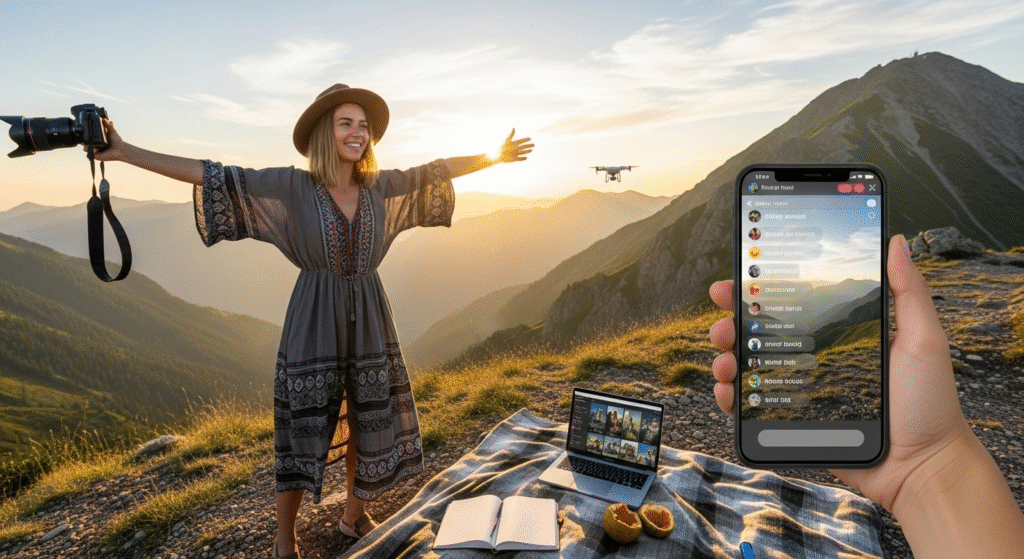
A travel influencer is someone who shares travel experiences on social media platforms, inspiring others to explore new destinations while collaborating with brands, tourism boards, and hospitality services. Unlike traditional travel agencies, travel influencers connect with audiences through storytelling, relatability, and authenticity.
Travel influencers create diverse content including personal journey narratives, practical planning advice, budget tips, destination guides, photography tutorials, and cultural insights. They document everything from luxury resort stays to backpacking adventures, making the world feel accessible to their followers.
The role extends far beyond posting pretty pictures. Travel influencers serve as guides, storytellers, and entrepreneurs all rolled into one, bringing the wonders of the world to life and allowing followers to come along for the journey. They research destinations, negotiate with brands, create content across multiple platforms, engage with communities, and constantly adapt to changing algorithms.
Do you know the difference between travel influencers and travel bloggers? Travel influencers focus on building personal brands and engaging audiences through visual platforms like Instagram and TikTok. Travel bloggers write detailed articles and guides on personal websites. Many successful creators do both, leveraging each platform’s strengths.
How Much Money Can Travel Influencers Make?

The average hourly pay for a travel influencer in the United States is $20.64 per hour, but earnings vary dramatically based on follower count, engagement rates, and monetization strategies.
Here’s the realistic income breakdown by follower tier:
| Influencer Tier | Follower Count | Per Post Earnings | Annual Potential |
|---|---|---|---|
| Nano | 1K-10K | $10-$100 | $5K-$15K |
| Micro | 10K-100K | $100-$1,000 | $15K-$75K |
| Mid-tier | 100K-500K | $1,000-$10,000 | $75K-$250K |
| Macro | 500K-1M+ | $10,000-$50,000+ | $250K-$1M+ |
Micro-influencers with 10,000 to 50,000 followers typically earn $100 to $500 per sponsored post, while mid-tier influencers with 50,000 to 250,000 followers can command $500 to $2,500 per campaign. Top travel influencers with over a million followers often earn six or seven figures annually through diversified income streams.
Real world example: Kristin Addis of Be My Travel Muse earned around $75,000 through Instagram in 2018 and was on course to make around $100,000 the following year, charging $500 per sponsored post with monthly income ranging from $5,000 to $15,000.
Here I’ve shared my own experience of earning $5000 while travel writing.
The key insight? You don’t need millions of followers to earn full-time income. Creators with just under 25,000 followers have earned over $10,000 from Amazon storefronts alone, selling over $300,000 worth of products and earning commissions. Success comes from strategic diversification, not just follower counts.
Choosing Your Travel Niche What Makes You Different
Starting without a clear niche makes you just another person posting travel photos. Most aspiring travel creators make a fundamental mistake by starting to post on social media with no concrete strategy, making them one of the herd with no way to distinguish themselves unless by sheer luck.
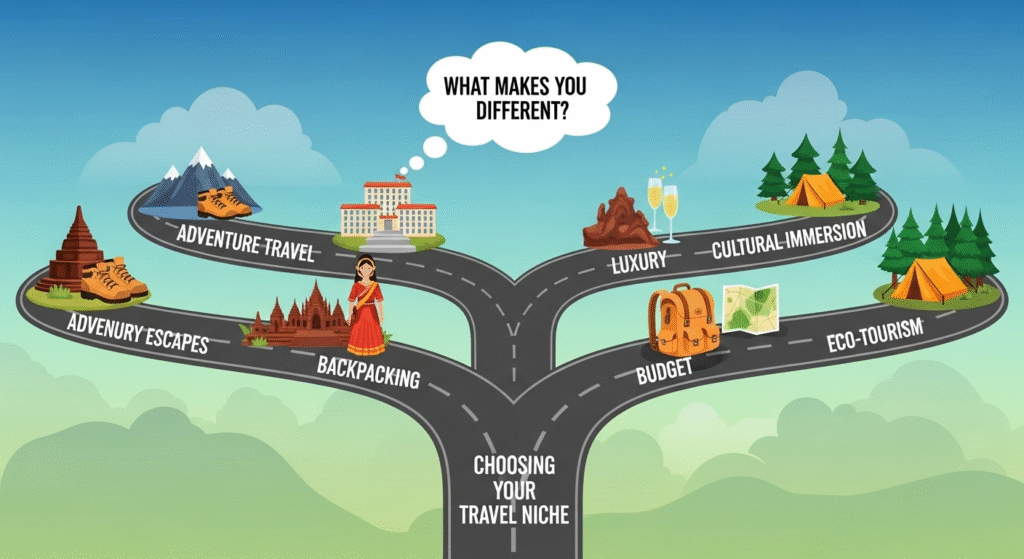
Popular profitable travel niches include:
- Budget travel: Backpacking tips, cheap flight hacks, hostel reviews, cost-saving strategies
- Luxury travel: High-end resorts, first-class flights, fine dining, exclusive experiences
- Adventure travel: Hiking, diving, safaris, extreme sports, adrenaline activities
- Solo travel: Safety tips, empowerment stories, destination recommendations for lone travelers
- Family travel: Kid-friendly destinations, travel logistics, educational experiences
- Sustainable travel: Eco-tourism, minimizing carbon footprints, supporting local communities
- Digital nomad lifestyle: Remote work setups, visa guides, coworking spaces, long-term travel
- Food and culinary travel: Local cuisine, street food tours, cooking classes, restaurant reviews
- Cultural immersion: Local traditions, language learning, authentic experiences, festivals
A niche helps you stand out from the crowd and allows you to build a community of like-minded individuals who value your content. Your niche should align with three factors: what you’re passionate about, what you’re skilled at, and what gaps exist in current travel content.
Ask yourself these strategic questions: What unique perspective can I offer? What travel experiences excite me most? What problems can I solve for other travelers? What content isn’t being created enough? Your answers reveal your differentiation strategy.
Setting Up Your Social Media Platforms the Right Way
Your social media profile is your calling card. It’s often the first thing brands, collaborators, and followers see, and if your profile is weak, you miss chances even if your content is great.
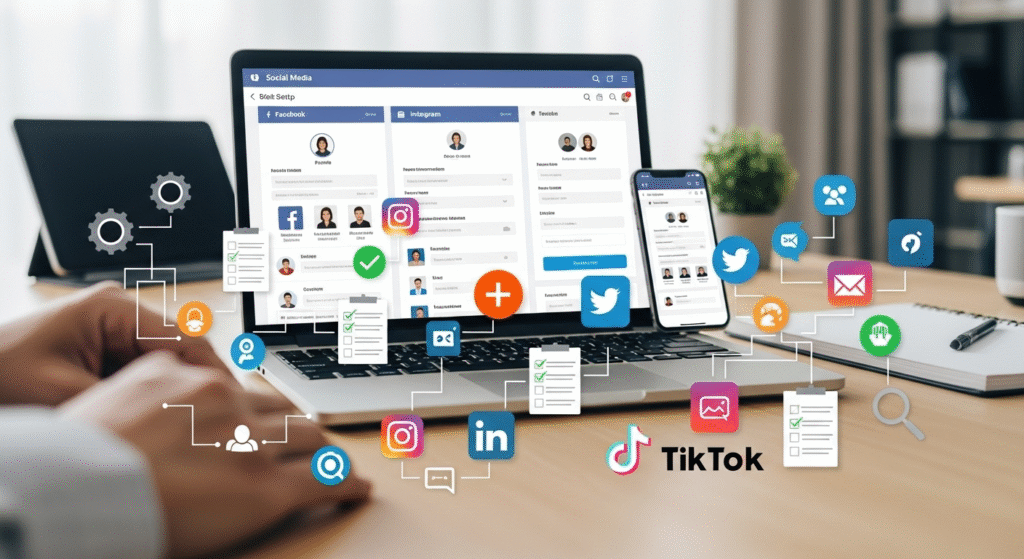
Instagram for Travel Influencers
Instagram remains the top platform for travel influencers due to its emphasis on high-quality visuals. The platform excels at sharing stunning photos, short videos through Reels, and engaging Stories that highlight picturesque destinations.
Create a cohesive Instagram aesthetic by choosing a consistent color palette, editing style, and content theme. Your bio should clearly communicate your niche, include relevant keywords, and feature a call-to-action link. Use a recognizable profile photo, preferably your face rather than landscapes.
Instagram growth strategies
Post at least once daily during the first three months to trigger algorithm favorability. For the first few months, post a minimum of two times a day, using scheduling services to automate frequent posts in advance. Mix content types including feed posts, Reels, Stories, and carousel posts to maximize reach.
TikTok for Rapid Growth
Despite the amount of people and competition TikTok has, it is quite easy to get at least one viral post due to the ongoing algorithm. The platform reaches nearly 700 million users and prioritizes content quality over follower count, making it ideal for new creators.
TikTok favors authentic, entertaining content over polished perfection. Share travel hacks in 15-second clips, document day-in-the-life adventures, participate in trending sounds, and create relatable travel humor. The algorithm rewards early engagement, so post when your target audience is most active.
YouTube for Long-Term Revenue
YouTube offers one of the most robust monetization ecosystems for travel creators. Between ad revenue, sponsored videos, affiliate links, channel memberships, and YouTube Shopping, creators build sustainable businesses here.
Typical travel vlogs on YouTube last anywhere between 10 to 15 minutes and viewers only stick around for the full length if the content is quality. This platform requires more equipment investment and editing skills but provides lasting value. A well-optimized travel video from years ago can still attract thousands of views through search.
Start with weekly uploads covering specific destinations or travel topics. Optimize titles with searchable keywords, write detailed descriptions, use relevant tags, and create eye-catching thumbnails. Consistency matters more than perfection initially.
Travel Blogging for SEO and Authority
Travel is not an impulse buy, and when people actually plan their travels, they are far more likely to search on Google than look for ideas on Instagram. A travel blog provides long-form content that ranks in search engines, generating passive traffic for years.
Your blog serves as your home base where you control everything. Create destination guides, travel itineraries, packing lists, budget breakdowns, and personal travel stories. Write comprehensive articles exceeding 2,000 words targeting specific search queries like “3 day Bangkok itinerary” or “budget travel Southeast Asia guide.”
Implement proper SEO by researching keywords using tools like Ubersuggest or Google Keyword Planner. Structure content with clear headings, include internal links, optimize images with alt text, and ensure fast loading speeds. Quality blog content establishes expertise and attracts brand partnerships.
Creating Content That Actually Stands Out
Quality content separates successful travel influencers from the masses. It’s hard for followers to feel connected to travel influencers who post generic travel photos, while travelers who post relatable or reasonably-aspirational content may find it easier to grow a following than influencers who project an unattainable lifestyle.
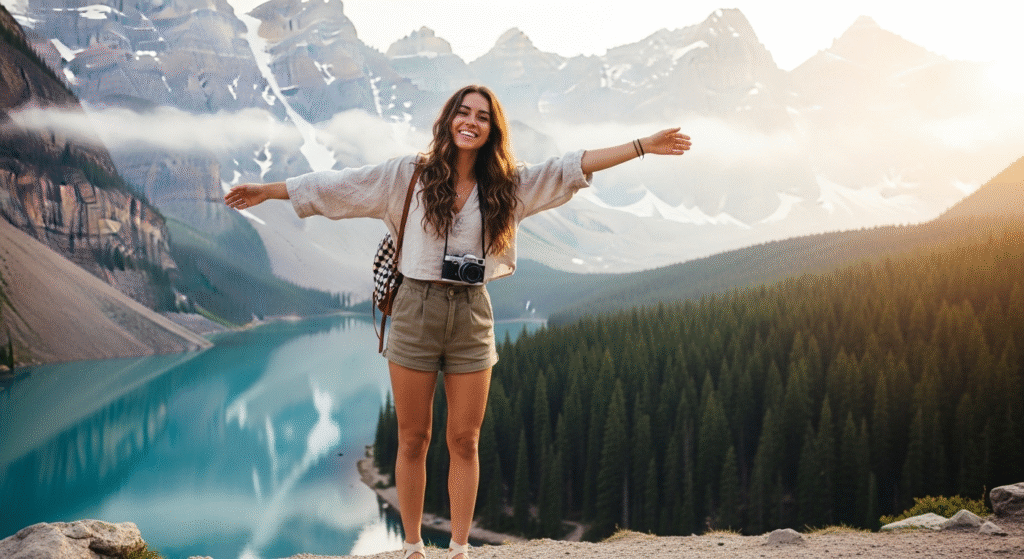
Essential Equipment for Travel Content Creation
Camera gear matters but don’t overspend initially:
Start with a quality smartphone capable of 4K video. Modern phones like iPhone 15 Pro or Samsung Galaxy S24 produce professional-quality content. Add a portable tripod for stable shots and selfie angles. Invest in a gimbal stabilizer for smooth video movement.
As you grow, consider upgrading to mirrorless cameras like Sony A7 series, Canon EOS R series, or Fujifilm X-T models. Add versatile lenses covering wide-angle for landscapes and standard zoom for portraits. A lightweight drone like DJI Mini 4 Pro captures stunning aerial footage.
Don’t forget practical essentials:
Portable chargers and power banks keep devices running during long exploration days. External hard drives back up irreplaceable travel footage. Waterproof cases protect equipment during water activities. Lightweight luggage with tech compartments organizes gear efficiently.
Content Types That Drive Engagement
Short-form videos dominate 2026 – It’s not easy to become a travel influencer without leveraging the mass appeal of share-worthy reels and TikToks, with an inspiring 10-second time-lapse or comical take on what NOT to do casting social media reach where it matters most.
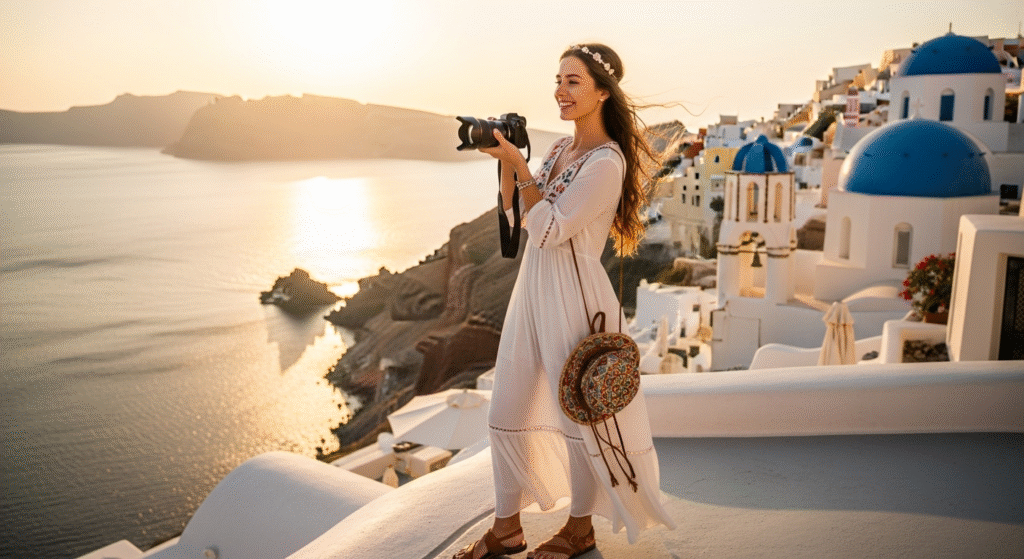
Create valuable content beyond beautiful scenery. Share packing tutorials, budget breakdowns, safety tips, hidden gem recommendations, cultural insights, language phrases, local food guides, and honest destination reviews. Educational content performs better than purely aesthetic posts.
Tell stories that resonate emotionally. Document challenges like missed flights, language barriers, or cultural misunderstandings. Show authentic moments, not just highlight reels. People are drawn to your distinct viewpoint because they crave experiencing the globe from your perspective, whether it’s your knack for finding beauty in overlooked places or how you turn any trip into an adventure worth telling.
Photography and Editing Tips
Develop a recognizable visual style through consistent editing. Choose a color palette that reflects your brand, whether that’s warm golden tones, cool blues, vibrant colors, or moody darks. Use the same editing presets across all photos to create cohesive feeds.
Shoot during golden hour (sunrise and sunset) for the most flattering natural light. Include yourself in photos to create personal connections. Experiment with perspectives by shooting from unusual angles, getting low to the ground, or capturing reflections. Balance landscape shots with close-ups, people, and details.
Learn basic editing in Lightroom Mobile or VSCO for photos and CapCut or InShot for videos. Don’t over-edit to the point of unrealistic imagery. Authentic content performs better than overly filtered photos that misrepresent destinations.
Building Your Audience and Growing Followers Organically
Growing an engaged audience takes time and strategy. Focus on quality followers who genuinely care about your content rather than vanity metrics.
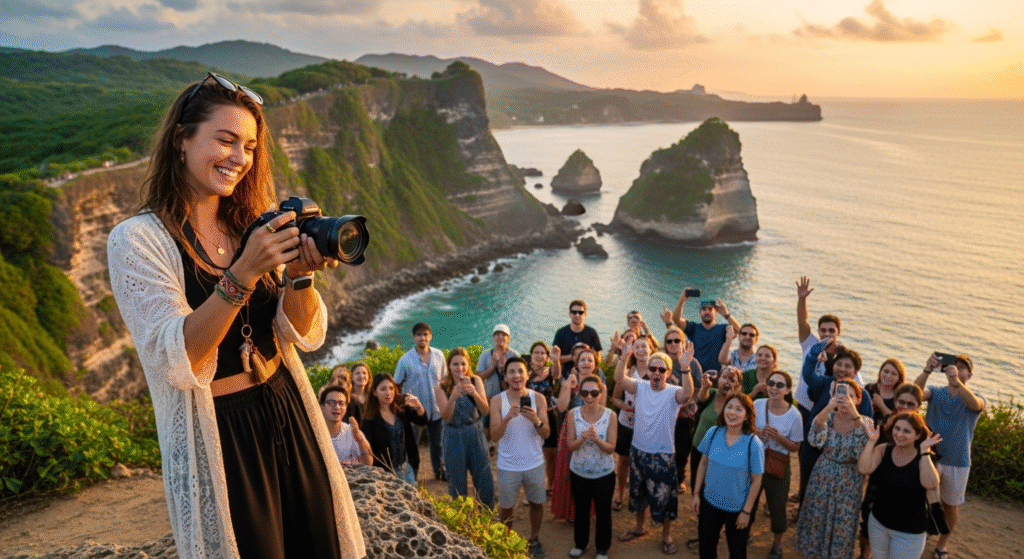
Hashtag Strategy That Actually Works
We’d all love to be featured on the popular tab for hashtags like #travelinfluencer or #solotravel but unless you’ve got 300,000 followers to boost you to that spot, instead find smaller niche hashtags that really work for your content.
Use a mix of hashtag sizes: 3-5 large hashtags (over 1 million posts) for broad reach, 10-15 medium hashtags (100K-1M posts) for targeted audiences, and 10-15 small hashtags (under 100K posts) for niche communities. Research hashtags by exploring what successful accounts in your niche use.
Effective travel hashtag categories
Destination-specific (#BaliBucketList, #TokyoTravel), niche-focused (#SoloFemaleTravel, #BudgetBackpacker), activity-based (#HikingAdventures, #FoodieTravel), aesthetic tags (#TravelPhotography, #Wanderlust), and community hashtags (#TravelBlogger, #TravelCreators).
Rotate hashtag sets to avoid appearing spammy to algorithms. Create a saved collection of 5-7 different hashtag groups and alternate between them. Track which sets drive the most engagement and refine accordingly.
Engagement Tactics That Build Community
For small creators to make it to a critical mass number of followers, we have to be approachable, engaging, and communicative, making followers feel like they matter while encouraging them to reach their own travel goals.
Spend 5 to 10 minutes, 1 to 2 times daily, commenting on and engaging with content posted by your followers. Respond to every comment on your posts within the first hour of publishing. Ask questions in captions to encourage conversation. Use interactive Story features like polls, questions, and quizzes.
Build relationships with fellow travel creators. Collaborate on content, share each other’s posts, create challenges together, and support one another’s growth. The travel community is surprisingly collaborative rather than competitive.
Host giveaways partnering with travel brands to boost visibility. Run contests requiring followers to tag friends, share content, or create user-generated content. These campaigns expand reach while rewarding loyal community members.
Consistency and Posting Schedule
Algorithms reward consistent creators. Posting daily or at least every other day is the best way to trigger Instagram’s algorithm and pick up more followers, with more traction in videos leading to more possibilities of paid sponsorships.
Create a content calendar planning posts two weeks in advance. Batch-create content during trips by shooting multiple outfits, locations, and concepts in single days. Schedule posts using built-in platform schedulers or third-party tools like Later or Planoly.
Post at optimal times when your specific audience is most active. Analyze insights to identify your best performing times. Generally, early mornings (7-9 AM) and evenings (6-9 PM) work well, but your audience patterns may differ.
Monetizing Your Travel Content Multiple Income Streams
Successful travel influencers diversify income through multiple streams rather than relying solely on sponsored posts.
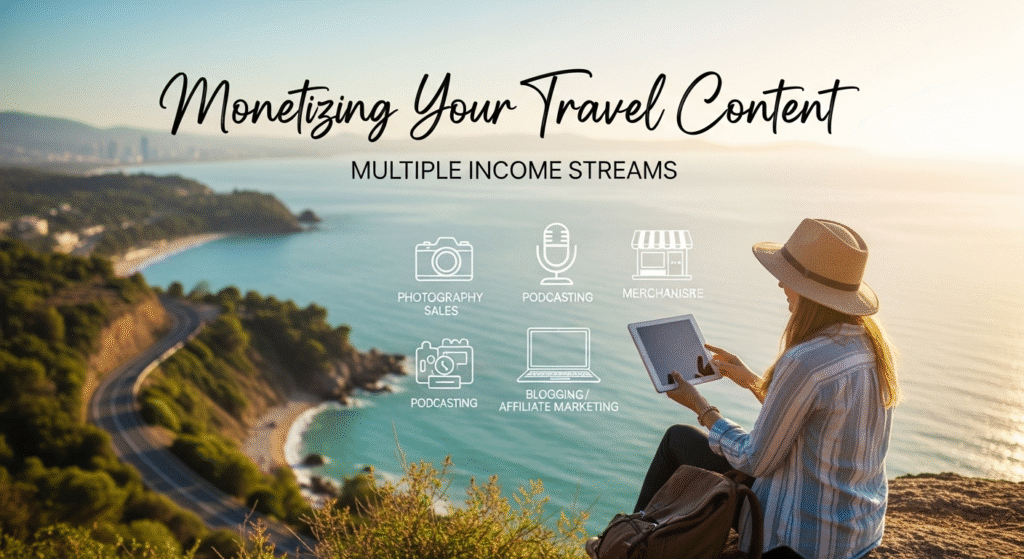
Brand Partnerships and Sponsored Content
Brand collaborations remain the primary income source for travel influencers. While hotels often provide complimentary stays, they rarely pay directly, so travel creators leverage these experiences to secure sponsorships with travel-friendly brands like clothing, beauty, or tech, or to sell content to tourism boards.
Build a media kit showcasing your statistics: follower counts, engagement rates, audience demographics, previous collaborations, and content examples. Update it quarterly as your metrics improve. Make it visually appealing and easy to scan.
Reach out to brands directly rather than waiting for them to find you. Research companies whose values align with yours. Send personalized pitches explaining why you’re a good fit, what you can offer, and specific campaign ideas. Follow up professionally if you don’t hear back.
Negotiate fair rates based on your metrics and deliverables. Don’t undersell yourself or accept exposure-only deals unless it’s a dream brand that provides significant value. Request half payment upfront for larger campaigns to protect yourself.
Affiliate Marketing for Passive Income
Affiliate marketing allows you to earn commissions by promoting products or services through unique links. Commission rates typically range from 5% to 20% per sale, with successful affiliate marketers earning substantial passive income and top affiliates averaging over $5,000 monthly.
Top affiliate programs for travel influencers:
Booking.com and Hotels.com for accommodation bookings (4-6% commission), Skyscanner and Kiwi.com for flight searches (small commissions but high volume), Amazon Associates for travel gear (1-10% depending on category), Viator and GetYourGuide for tours and activities (8-10%), travel insurance providers like SafetyWing (10-15%).
Promote affiliate products authentically. Only recommend items you genuinely use and believe in. Disclose affiliate relationships transparently in captions and videos. Create dedicated guides like “My Essential Packing List” or “Best Travel Cameras Under $1000” that naturally incorporate affiliate links.
Track which products convert best and focus promotional efforts there. Use link tracking tools like ThirstyAffiliates or Pretty Links to monitor performance. Test different product categories to discover what resonates with your audience.
Creating and Selling Digital Products
Digital products provide scalable income without trading time for money. Creating and selling digital products like travel e-books, travel guides, travel itineraries, Lightroom presets, or online courses is a lucrative income stream that can be sold repeatedly with minimal ongoing effort.
Profitable digital product ideas:
Comprehensive destination guides covering where to stay, eat, and explore (sell for $10-$50), detailed itineraries with day-by-day plans and bookings (sell for $15-$75), photography presets that recreate your signature editing style (sell for $20-$100), online courses teaching travel photography, content creation, or trip planning ($50-$500).
Create products solving specific problems your audience faces. Survey followers asking what they struggle with most. Deliver premium value that justifies the price point. Use platforms like Gumroad, Teachable, or your own website to sell products.
Promote digital products regularly without being pushy. Mention them in relevant content, share customer testimonials, offer limited-time discounts, and create lead magnets like free mini-guides that upsell to premium versions.
YouTube Ad Revenue and Memberships
YouTube creators earn money through multiple platform features beyond just ad revenue. The Google AdSense program pays based on views, with travel content typically earning $2-$10 per 1,000 views depending on audience location and engagement.
Enable YouTube memberships once you reach 30,000 subscribers, allowing fans to pay monthly fees for exclusive perks like behind-the-scenes content, early video access, custom badges, and members-only live streams. Price tiers between $0.99 and $19.99 monthly.
Super Thanks lets viewers tip on individual videos they especially enjoyed. YouTube Shorts Fund pays bonuses to creators whose Shorts perform exceptionally well. These supplementary income streams add up significantly over time.
Additional Monetization Strategies
Consulting and coaching services: Once established, offer one-on-one sessions teaching others how to grow travel accounts, improve photography, or plan trips. Charge $100-$500 per hour based on your expertise.
Speaking engagements: Travel influencers get invitations to speak at workshops, conferences, and events where they can share their expertise and experiences, getting additional exposure and an addition to their overall income.
Hosting group trips: Lead tours for followers who want to travel with you. Price trips to cover your costs plus profit margins. This creates unforgettable shared experiences while generating significant income from a single trip.
Photography sales: License your travel photos to stock photography sites, sell prints through print-on-demand services, or offer photography services to tourism boards and travel companies.
Working With Tourism Boards and Travel Brands
Tourism boards and destination marketing organizations actively seek travel influencers to promote their regions. These partnerships often provide the most comprehensive value through free accommodations, activities, meals, and sometimes payment.
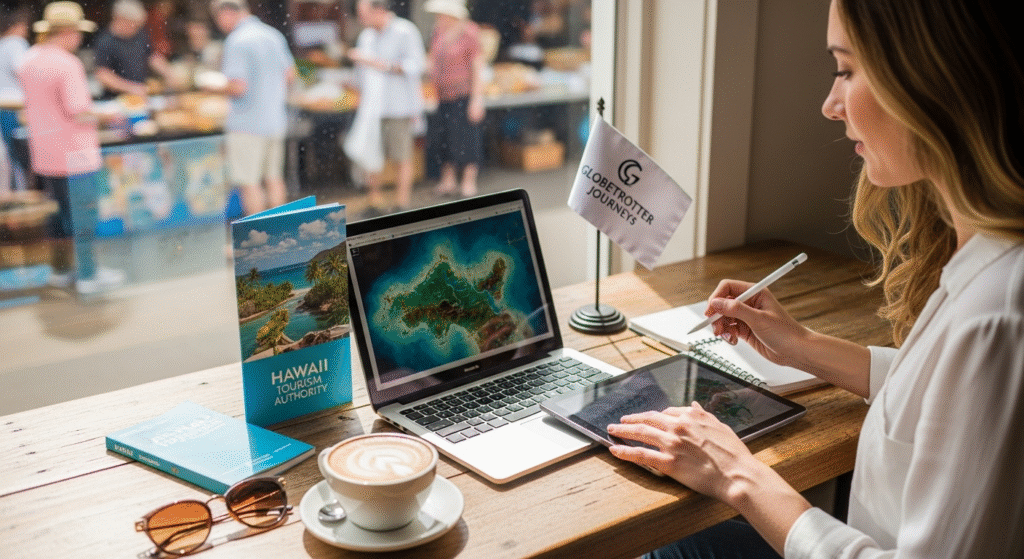
How to Pitch Tourism Boards?
Research tourism boards’ current marketing campaigns and priorities. Visit their websites, search for the following –
- travel “submit guest post“
- write for us travel
- “write for us” + travel paid
- write for us blog
- write for us + lifestyle
- write for us adventure
- hotel write for us
- travel write for
- accepting guest posts
- write for us + travel
- travel + write for us
- “write for us” + travel paid
- “write for us” + travel
- travel + “write for us”
- “write for us”+travel
- write for us travel paid
- travel guest post write for us
- travel blogs write for us
- travel tips write for us
- lifestyle “write for us”
- write for us travelling
- travel guide write for us
- blogging tips write for us
- write for us travel website
- keyword intitle:”write for us”
- lifestyle blog write for us
- adventure travel write for us
- tour and travel write for us
Follow social media accounts, and understand their target audiences. Tailor pitches showing how your content aligns with their goals.
Create professional pitch emails including a brief introduction, your relevant statistics, why you’re interested in their destination, what content you’ll create, and how you’ll promote their region. Attach your media kit as a PDF.
Do you know timing matters when pitching? Contact tourism boards 3-6 months before you want to travel. They plan campaigns seasonally and need advance notice to arrange accommodations and activities.
Follow up once after two weeks if you don’t receive responses. Be professional and gracious whether they accept or decline. Build relationships even when campaigns don’t work out immediately.
Press Trip Expectations and Etiquette
Press trips or FAM (familiarization) tours involve groups of influencers experiencing destinations together. Tourism boards organize packed itineraries showcasing attractions, restaurants, hotels, and activities.
Deliver on your commitments. Create the promised content volume and quality. Post within agreed timeframes. Tag partners correctly and use campaign hashtags. Submit deliverables like high-resolution photos or usage rights as requested.
Be professional throughout. Arrive on time, dress appropriately, engage positively with fellow influencers, thank hosts publicly and privately, and represent your personal brand well. Your reputation affects future opportunities.
Remember that an influencer’s experience will likely be different from a regular traveler’s, as tourism boards often open attractions before public timings and make special arrangements that can’t be replicated for followers. Maintain authenticity by disclosing sponsored experiences while still providing honest insights.
Common Mistakes New Travel Influencers Make
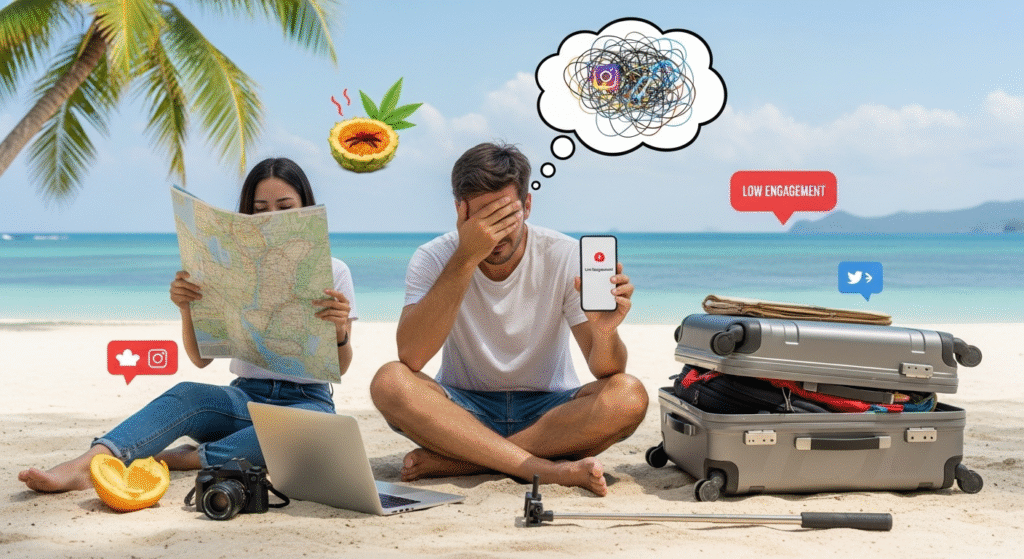
Buying followers destroys credibility: Purchased followers don’t engage with content, tank your engagement rate, and make you unattractive to brands. Engagement matters more than numbers, and algorithms reward consistency. Grow organically even if it’s slower.
Chasing free trips only: Brands look for long-term partnerships, not one-time freebies. Position yourself as a professional content creator offering marketing value rather than someone seeking free vacations.
Ignoring SEO completely: Without SEO, your blog or YouTube channel won’t grow organically. Learn basic keyword research and optimization to capture search traffic providing sustainable growth.
Inconsistent posting schedules: Algorithms favor active accounts. Disappearing for weeks then posting multiple times daily confuses algorithms and followers. Maintain steady, predictable schedules.
Generic content without personality: Standing out requires unique perspectives. Share your actual opinions, experiences, fears, and excitement. Authenticity creates deeper connections than perfectly curated content.
Neglecting community engagement: Spend time commenting, messaging, and engaging with content posted by your followers to build genuine relationships. One-way broadcasting doesn’t build loyal communities.
Copying successful influencers: While learning from successful creators helps, directly copying aesthetics, captions, or concepts comes across as inauthentic. Find inspiration but develop your unique voice.
Staying Authentic in the Influencer Economy
The pressure to constantly create content and maintain perfect feeds can destroy travel’s authentic joy. The glamorous world of travel influencers is often filled with insecurities, challenging negotiations, and immense pressure to ‘fake it till you make it’.
There was a time when travel bloggers published one blog post a week or month because slow exploration and crystallizing experiences into meaningful stories takes time, but now creators are expected to churn out content like a factory across posts, reels, stories, blog posts, YouTube videos, shorts, and multiple platforms.
Set boundaries protecting your mental health and travel enjoyment. Not every moment needs documentation. Some experiences can remain private and personal. The persona of a traveler and the label of an influencer are often at loggerheads with each other, as the weight of an influencer tag can destroy the authenticity of travel.
Tips for maintaining authenticity:
Travel sometimes without creating content, experience destinations as a regular tourist rather than always on press trips, share honest reviews including negative aspects, admit when content is sponsored or gifted, show behind-the-scenes struggles, and prioritize experiences over content.
Building your values into your content strategy is the best way to ensure your stories will still matter even tens of years from now. Consider your platform’s purpose beyond personal gain. What positive impact can you make? How can you promote responsible, sustainable, and respectful travel?
Travel Influencer Ethics and Responsible Tourism
With influence comes responsibility. Influencers are constantly called out for geotagging or ignorantly accentuating other irresponsible travel practices. Your content impacts real places and communities.

Ethical considerations for travel influencers
Avoid geotagging fragile natural areas that can’t handle increased tourism. Research cultural norms and respect local customs. Don’t trespass or endanger yourself for content. Support local businesses rather than international chains. Minimize environmental impact through sustainable choices. Present destinations honestly rather than creating unrealistic expectations.
Promote diversity in travel content. The industry has historically centered specific demographics. Use your platform showcasing diverse travelers, destinations beyond typical Western hotspots, and varied travel styles from budget to luxury.
Address overtourism concerns thoughtfully. If destinations are already overcrowded, consider whether promoting them further helps or harms. Highlight alternative destinations absorbing tourist interest from struggling areas.
Be transparent about partnerships and gifted experiences. Disclose sponsored content clearly following FTC guidelines. Maintain editorial independence by sharing honest opinions even when working with brands.
Legal and Business Considerations
Treat your travel influencer work as a legitimate business requiring proper structure.
Business setup essentials:
Register as a sole proprietor or LLC depending on your location and income level. Obtain necessary business licenses. Separate personal and business finances with dedicated bank accounts and credit cards. Track all income and expenses meticulously for tax purposes.
Tax obligations:
Report all income including cash payments, gifted trips, and product values. Deduct legitimate business expenses like equipment, travel costs for content creation, software subscriptions, and home office space. Consider quarterly estimated tax payments once earning significant income. Consult tax professionals familiar with influencer businesses.
Contracts and agreements:
Use written contracts for brand partnerships specifying deliverables, timelines, payment terms, usage rights, and revision policies. Protect yourself legally while clarifying expectations. Templates are available online or through legal services like LegalZoom.
Insurance needs:
Carry liability insurance protecting against potential lawsuits. Travel insurance covering equipment, trip cancellations, and medical emergencies. Consider business interruption insurance if influencing becomes your primary income.
Long-Term Career Development and Sustainability
Success requires consistent effort, creativity, and willingness to adapt to changes in the industry, keeping up with the latest trends in travel, digital marketing, and social media algorithms.
Skills worth developing:
Advanced photography and videography techniques, video editing proficiency, copywriting and storytelling abilities, SEO and digital marketing fundamentals, basic graphic design, social media analytics interpretation, negotiation and business communication, and personal branding strategy.
Invest in continuous learning through online courses, workshops, and industry conferences. Stay current with platform changes, algorithm updates, and emerging trends. Follow industry publications and successful creators analyzing what works.
Diversification protects against platform changes:
Don’t rely entirely on one platform or income stream. Instagram could change algorithms tomorrow. TikTok faced potential bans. YouTube adjusts monetization requirements. Build presence across multiple platforms and income sources creating stability.
Consider long-term career evolution. Some influencers transition into travel writing, photography, content marketing for brands, tourism consulting, or creating their own travel companies. Think beyond influencing to complementary career paths.
Frequently Asked Questions About Becoming a Travel Influencer
Can I start as a travel influencer without traveling internationally?
Yes, share local adventures, hidden gems in your city, or nearby road trips as audiences value authentic content over exotic destinations. Micro-adventures and exploring your own region can build engaged audiences before international travel.
How long does it take to make money as a travel influencer?
Expect at least 6 to 12 months of consistent effort before monetizing meaningfully. Some creators see opportunities sooner through micro-influencer programs while others take longer building credibility. Consistency and quality accelerate timelines.
Do I need a blog or is social media enough?
Social media builds fast visibility, but a blog gives you long-term Google SEO traffic and more control over your brand. Successful creators typically combine both strategies maximizing different audience discovery methods.
What if I can’t afford to travel frequently?
Start locally documenting your area’s hidden gems and attractions. Save money through budgeting, side hustles, or travel hacking with credit card points. As you gain followers, partnerships provide sponsored travel opportunities reducing costs.
How do I stand out in such a saturated market?
Specialization differentiates you. Specializing in a niche can help you grow faster than being just another travel influencer, and you can always broaden your niche later. Combine multiple interests creating unique angles like “vegan food in Asia” or “accessible adventure travel.”
Is it too late to become a travel influencer in 2026?
The world is completely different than a decade ago with thousands trying to make it as travel influencers, but you can still stand out through brainstorming strategy and asking what you’re good at, what you feel passionate about, and what the world needs that you don’t see enough of.
What platforms should I focus on first?
Start with Instagram and TikTok for visual travel content, then expand to YouTube for longer storytelling and a blog for SEO benefits. Master one platform before spreading too thin across all channels.
How important is video content versus photos?
Video dominates 2026 social media algorithms. While stunning photography still matters, short-form video content drives the most engagement and growth. Invest time learning video creation and editing.
Taking Your First Steps Today
Building a career as a travel influencer requires a combination of passion and savvy social media skills, with establishing a strong online following taking time but going a long way toward helping you earn a living creating content.
Start today rather than waiting for perfect conditions. Create your first account, post your first photo, write your first blog article. Imperfect action beats perfect inaction every time.
Wanting to ‘be an influencer’ is a fine goal, but what will you do with your platform when you get it? Define your purpose beyond personal gain. How will you inspire others? What value will you provide? What stories deserve telling?
Becoming a travel influencer is a journey marked by passion, creativity, and the desire to share the world through your eyes, crafting stories, forging connections, and inspiring wanderlust with every post and adventure. The path demands dedication and strategic approach, but personal and professional rewards are boundless.
Your unique perspective makes content compelling and experiences unforgettable. The world doesn’t need another generic travel account. It needs your specific voice, your particular interests, your individual way of seeing places. That authenticity creates lasting impact and sustainable success.
Remember that every successful travel influencer started exactly where you are now, with zero followers and big dreams. The difference between those who succeed and those who don’t isn’t talent or luck but consistent effort, strategic thinking, and genuine passion for both travel and community building.
Start your journey today. The world is waiting to see it through your eyes.
